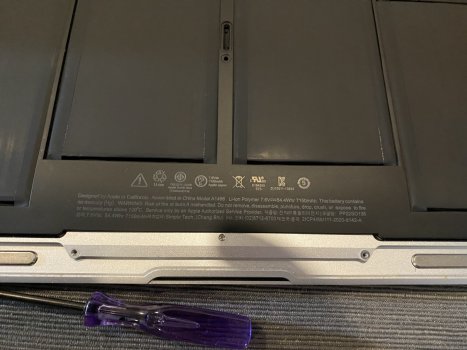I need some guidance from those of you that are more experienced with newer laptop batteries than me. I just replaced the battery in my 2017 13 inch MBA (Intel i5) with a new OEM apple battery. Along with the battery came a booklet on various aspects of battery care, including “calibrating your laptop battery to optimize his performance.” However, the steps it gives don’t seem to match up fully with the options I see on the screen and I’d love some opinions on what I should actually do now that I’ve put a new battery in this thing.
This is what the instructions read:
Calibrate your laptop battery to optimize its performance
Inside the laptop battery is microprocessor software, which calculates the battery volume during the charging/discharging. Batteries must be calibrated from time to time to ensure correctness of the time and the percentage displayed on the screen. You must implement a complete cycle of charging and discharging the battery at the beginning of using the computer, and repeat this cycle every two or three months. The charging and discharging procedure is as follows:
1. Set the Power Supply option first: Right click on the screen and select
Property -> Screen Saver -> Power Supply > Power Use Scheme > Portable. In all the subsequent operations such as When Computer and Use Battery, select Never. Under the Alert option, deselect Alert for deficient battery and Alert for serious battery shortage.
2. Disconnect the power adapter and use the battery until the computer is powered off due to exhaustion of the battery.
3. Connect the power adapter until the battery is charged to 100%. Before initial use of the computer (or resuming use of the computer after long-term storage), the battery must be charged to full and discharged for 3-4 times to optimize the performance. The charging process takes more than five hours.
4. Note: When your battery is calibrated and reaches the best performance, set the Power Supply Options on your computer to the default value to ensure that the computer can send correct alerts to you, for example, low battery alert, and alert before the computer enters the hibernation status.
You must discharge the battery to let the computer power off, and then charge the battery to 100% to calibrate it. Then you can connect or disconnect the power supply anytime regardless of the status of the battery volume. Moreover, you can perform a deep charging and discharging cycle under control of the protection circuit in a time
segment to calibrate the electricity statistics of the battery. However, this does not increase the actual capacity of the battery.
Tips: When the battery becomes "empty", the computer enters the hibernation mode forcibly. The battery reserves a certain electricity volume to ensure that the computer can hibernate for a time segment. When the battery is really exhausted, the computer is powered off forcibly. At this time, any open documents will be lost.
This is what the instructions read:
Calibrate your laptop battery to optimize its performance
Inside the laptop battery is microprocessor software, which calculates the battery volume during the charging/discharging. Batteries must be calibrated from time to time to ensure correctness of the time and the percentage displayed on the screen. You must implement a complete cycle of charging and discharging the battery at the beginning of using the computer, and repeat this cycle every two or three months. The charging and discharging procedure is as follows:
1. Set the Power Supply option first: Right click on the screen and select
Property -> Screen Saver -> Power Supply > Power Use Scheme > Portable. In all the subsequent operations such as When Computer and Use Battery, select Never. Under the Alert option, deselect Alert for deficient battery and Alert for serious battery shortage.
2. Disconnect the power adapter and use the battery until the computer is powered off due to exhaustion of the battery.
3. Connect the power adapter until the battery is charged to 100%. Before initial use of the computer (or resuming use of the computer after long-term storage), the battery must be charged to full and discharged for 3-4 times to optimize the performance. The charging process takes more than five hours.
4. Note: When your battery is calibrated and reaches the best performance, set the Power Supply Options on your computer to the default value to ensure that the computer can send correct alerts to you, for example, low battery alert, and alert before the computer enters the hibernation status.
You must discharge the battery to let the computer power off, and then charge the battery to 100% to calibrate it. Then you can connect or disconnect the power supply anytime regardless of the status of the battery volume. Moreover, you can perform a deep charging and discharging cycle under control of the protection circuit in a time
segment to calibrate the electricity statistics of the battery. However, this does not increase the actual capacity of the battery.
Tips: When the battery becomes "empty", the computer enters the hibernation mode forcibly. The battery reserves a certain electricity volume to ensure that the computer can hibernate for a time segment. When the battery is really exhausted, the computer is powered off forcibly. At this time, any open documents will be lost.



